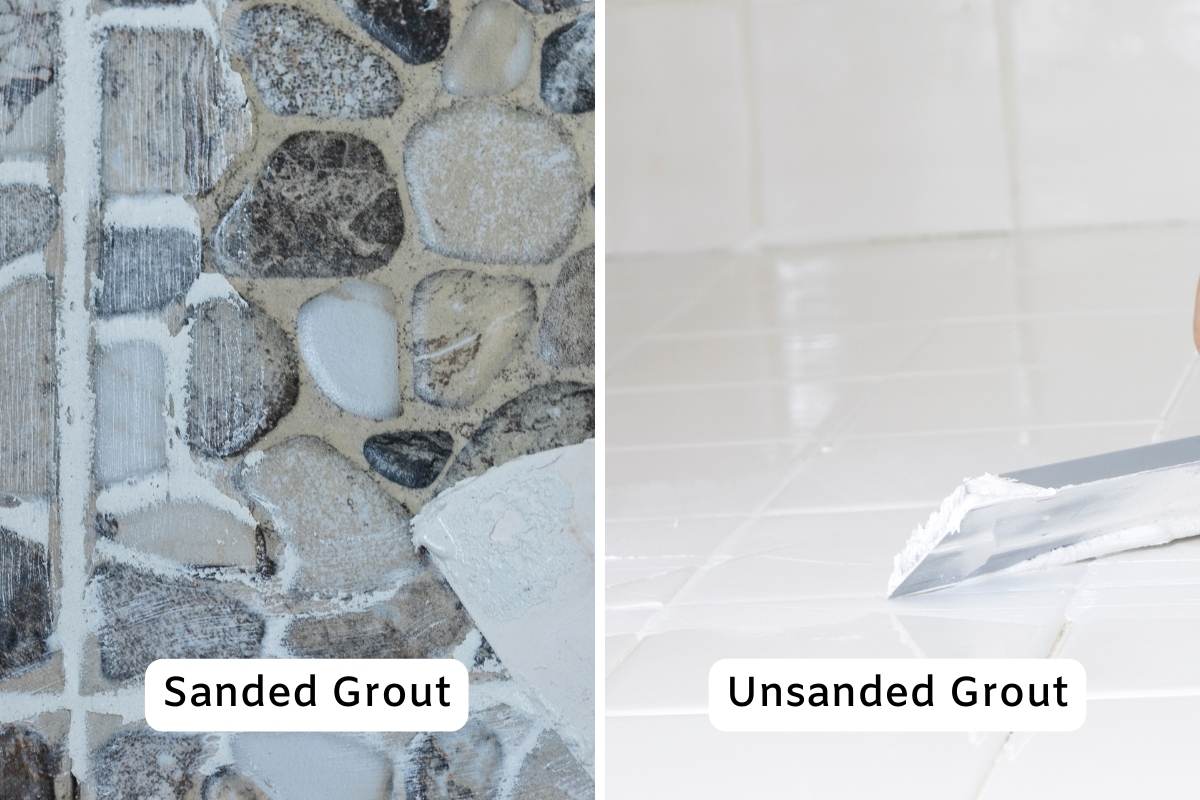Sanded and unsanded grout are both types of grout used for sealing the lines between tiles. The main differences between them include their cost, tile surfaces, recommended uses, grout widths, durability, thickness, and suitability for smooth tiles. To fully grasp the differences between sanded vs unsanded grout, let’s go over each in detail.
Quick Comparison Summary
Sanded grout consists of certain chemicals and silica sand particles. It’s recommended for creating wider grout lines or denser joints. It can also join well together to create a sturdy joint. Sanded grout is very porous, so sealing it is necessary. This will stop water from reaching beneath the tile and damaging the substrate holding the tile on the floor.
Unsanded grout is also called non-sanded grout. This grout is ideal for creating extremely small grout lines ranging from 1/8 – 1/16″. It lacks the silica aggregate material, which enables it to make thinner grout lines.

Cost
When it comes to affordability, sanded grout clearly has the upper hand because it’s way less expensive than unsanded grout. For this reason, we recommend sanded grout for people on a low budget.
However, the pocket-friendly cost of sanded grout comes at a price. Sanded grout is far cheaper than unsanded grout simply because it’s sourced from sand, which is incredibly cheap. Aggregate sand material makes up most of the sanded tile grout.
Unsanded tile grout, on the other hand, is manufactured using polymers, which are more expensive than sand. This is why unsanded tile grout is costlier than sanded grout.
Tile Surface Recommendations
Sanded grout is recommended for tile surfaces where the likelihood of scratching from the sand content in your grout is high. This is because it’s easy to scratch from the sand content in the grout without ruining your work.
We recommend sanded grout for DIYers and amateur grouters because they will likely need to regrout more than once to get it right. Also, sanded grout is very harsh to surfaces that are suitable for unsanded grout. It functions like sandpaper, which means it can damage smooth tiles. The sand used for producing the sanded grout is typically harder than soft stones.
On the flip side, unsanded grout is the right grout for delicate tile surfaces that are easily scratched. Tile surfaces are good for specific porcelain tiles, glass tiles, natural stone, and ceramic tiles.
For best results with smooth and polished tiles, professionals usually use epoxy-based unsanded grout.
The sanded and unsanded grout have an epoxy-based form, which is different from the traditional grout. They are made with certain chemicals which differentiate them from Portland cement. They use an activator and a base. Once you add the base to the activator, the grout cures in an irreversible chemical reaction, which results in a very strong hold.
However, epoxy grout is way more expensive than conventional unsanded grout. It also has a brief cure time, making it difficult to use. Professional tilers strictly use it.
Failure to coat the whole vertical surface with epoxy grouts before it cures will make the grout very stiff and difficult to move or spread. This can get a bit easier if you’re using a mixer, but the work will still prove very challenging if you’re covering a large area.
Despite the discouraging shortcomings associated with the unsanded epoxy grout, it’s hands down the best option if you’re working on tile joints that require a grout line that’s over 1/8″
Recommended Uses
Sanded and unsanded grout has their respective uses. By default, both are used for interior flooring. For instance, sanded grout is your go-to option if you want to tile your walls or floors.
Sanded grout is very common and easily accessible. It comes in various colors, and it lessens grout shrinkage. In fact, sanded grout has much more uses than unsanded grout because it’s used for virtually everything. The few exceptions are those that require only unsanded grout.
We don’t advise using unsanded grout for general tiling because it doesn’t hold up the way sanded grout does. Now, when it comes to the uses of unsanded tile grout, some of those uses apply to sanded grout as well. We’re referring to tile projects on vertical surfaces (shower walls). However, unsanded grout will be a better option for such uses.
The unsanded grout gains the upper hand over sanded grout in vertical tiling because it glues more effectively on vertical tile surfaces. Also, it does this with a reduced quantity of slumps, unlike sanded grout slumps.
Because unsanded grout is primarily made of polymer, its material has very little porosity. So it may not require sealing.
Durability
Unsanded grout is very sticky because it lacks sand particles. This makes it very easy to spread on a vertical surface because unsanded grout floats effortlessly, and you can easily work it into the grout joints. But unsanded grout shrinks after it dries, which can result in the grout pulling away from the tiles.
The short cure period and shrinkage have nothing to do with the durability of the tile installation. However, the absence of sand in its composition makes it less durable than the sanded grout. When the unsanded grout is used for the tiles on the shower wall, it will remain intact because there’s little or no pressure applied to it.
Sanded grout is an easy winner in the sanded vs. unsanded grout’s durability contest because sand prevents the grout from shrinking significantly.
When sanded grout cures, the sand sets in place and becomes stiff. This glues the tile properly and keeps them in place despite heavy foot traffic. It is more equipped to handle areas with more foot traffic than unsanded grout.
Sanded grout is also crack-resistant, while unsanded grout is prone to cracking when it gets the kind of pressure sanded grout gets. This is why unsanded grout is not used for most flooring jobs.
However, if your work area involves large tile joints, you can’t use any sanded grout. For jobs that require a grout line measuring ⅜”, you’ll need to use a kind of sanded grout called wide-joint mixture grout. They are sold in virtually every hardware or flooring store.
This sanded grout is ideal for projects requiring larger grout lines because it’s made up of more aggregate material. This means it shrinks less after drying.
Widths
Sanded grout is ideal for grout lines with a measurement that falls between ⅛-½”. Anything bigger than a half-inch for sanded grout is not feasible. It will be unstable and prone to cracking.
Also, the sand in the sanded grout makes your grout bulky and thus hard to work or spread into these thin seams. Sanded grout in small tile joints can trigger pinholing. This means that you may have to use more water in the base. While this makes spreading or working the grout easier, excess water will cause the formation of pinholes.
The excess water will take a long period to evaporate, but when this occurs, the grout placed above the now-vacant air cavity will collapse. This will cause a pin-like hole to form. Pinholes on your tiles are bad for business because they indicate poor workmanship.
On the other hand, unsanded grout is also used to work on lines that are ⅛ of an inch. It overlaps with the sanded grout here, but sanded grout should be the first choice here.
Unsanded grout is meant for thin grout lines (⅛ – 1/16″) because it will adequately compact into these widths of lines. Anything bigger than ⅛” will result in slumps, crack, or poor filling after unsanded grout dries.
FAQs
Is sanded grout harder to clean than non-sanded grout?
Yes. Cleaning sanded grout is more difficult than non-sanded grout. Sanded grout has a coarse and porous texture, making it prone to grout staining. However, the easiest way to clean grout is with vinegar and lemon solution or with grout cleaning solutions and a brush.
Does sanded and unsanded grout have the same curing time?
The curing time for both is virtually the same. They both take around three days to dry. However, we recommend waiting for up to a week before exposing them to moisture.
To Sum Up
Here’s a quick recap of the various differences between the sanded and unsanded grout.
The benefits of sanded grout include affordability, suitability for wider grout lines, and availability in a larger variety of colors. The sanded grout is hard to work into thin lines, scratches smooth surfaces, and requires sealing by a water-based penetrating sealer.
The unsanded grout requires a reduced volume of slumps on vertical surfaces, doesn’t require grout sealing in all applications, and is more suitable for thin seams and sensitive tile surfaces. Unsanded grout isn’t suitable for wider lines or seams and has less range of color choices.










